
EC project "Review of Historical Seismicity
in Europe" (RHISE) 1989-1993

|
[Deliverables and queries] [Presentation] [Homepage] |
Introduction
The compilation of parametric earthquake catalogues
covering areas, and/or time-windows, broader than those covered by two, or
more, existing catalogues, is a problem well known to many investigators;
some aspects are discussed for instance by Van Gils (1988), Stucchi (1994)
and others.
The compilation is generally performed converting
the input catalogues into a comprehensive format, merging them into a single
file and then sorting out possible duplications: this operation is usually
accomplished with the help of almost automatic tools. To follow this procedure
implies the following, hidden assumptions:
- parameters of input catalogues are homogeneous;
that is, each parameter called in the same way represent the same quantity
and is expressed in the same unit;
- parameters are derived from primary data with
homogeneous procedures;
- compilers are confident that their authomatic
routines are so highly performing to be able to master possible duplication
or similar problems.
Unfortunately, these assumptions seldom meet
the reality. It is well known to most compilers, and it is discussed also
in this volume, that parametric catalogues are far from being homogeneous
and transparent. Therefore, the compilation of comprehensive, parametric
catalogues often results in propagation and amplification of errors and in
increasing internal inhomogeneity of the final product. The most frequent
problems are:
- earthquake duplications (or losses)
- inhomogeneity and forced parameterisations.
It is to be stressed that most of these problems
are also met inside national catalogues, as they are often compiled following
the same procedures.
Earthquake duplications
The most common problem is duplication, that
is, the presence of double or multiple entries representing the same event,
carrying different set of parameters. The sources of duplication cover a
wide range: they go from simple mistakes in the compilation of some parameters
to different compilation procedures. But the most frequent source is the
use of different sets of primary data and/or errors in historical interpretation.
Duplication problems derived from the latest
source are well known as they are discussed for instance by Alexandre (1991),
Bellettati et al. (1993) and many others. The examples which follow deal
with cases covering also the instrumental period and even the most recent
one.
The "Italian" catalogues
The Postpischl (1985) catalogue put together
many entries of varied origin. The main contributing sets are parametric
catalogues, such as: Enel file (1978; about 20600 entries), Carrozzo et al.
(1973; about 435), Dell'Olio and Molin (1980; about 5500), Bernardis et al.
(1977; about 1800), Carrozzo et al. (1975; about 7600). While the first two
sets cover the whole territory, the other sets cover limited areas (Central
Italy, Eastern Alps, Calabria and Sicily).
After merging the input catalogues, Postpischl
sorted out many problems authomatically; but the huge task and the limited
time did not allow avoiding some pitfalls, to be mastered with careful analysis
only. Therefore, a limited, but significant number of duplications survived;
an example follows.
1939.02.11.
The two following entries are compiled
on the basis of Bernardis et al. (1977) and Enel (1978) respectively (Fig.
1a):
| Date | Time | Lat | Lon | M | Io | Ep.Area | |
| 1939 02 11 | 11 16 | 46 06 | 13 06 | 65 | FAGAGNA | (B) | |
| 1939 02 11 | 11 16 54 | 44 04 | 11 39 | 52 | 70 | MARRADI | (E) |
The search for the roots of the two entries leads respectively to Caloi (1939) and to Malaroda and Raimondi (1957), via Karnik (1969). Malaroda and

Raimondi initially reported two entries; in
their final table, however, only the second one, the origin of which is unknown,
survived. Finally, Bernardis et al. (1977), dealing only with the Eastern
Alps area, preserved the second entry which, later on, was assumed also by
Postpischl (1985).
Neighbouring countries catalogues: Italy
and Slovenia
1889.09.02. The following entries are taken from Ribaric (1982) and Postpischl (1985) respectively (Fig. 1):
| Date | Time | Lat | Lon | M | Io | Ep. Area | |
| 1899 09 02 | 45 87 | 13 98 | 30 | BUDANJE | (*) | ||
| 1899 09 02 | 10 10 | 45 37 | 11 15 | 50 | VALDAGNO | (o) |
The search for the roots of the second record
leads to Cancani (1900). The root of the Ribaric (1982) record are Mojsisovics
(1900) and Bernardis et al. (1977). Strangely enough, Bernardis et al. (1977)
quote an unpublished Slovenian catalogue by Ribaric as a source! It must
be said that cross- references between these two catalogues are not an unfrequent
case.
The Van Gils and Leydecker (VGL)
catalogue
As already remembered, the compilation of this
catalogue did not follow the recommendations which are found in the introduction
to the catalogue itself (Van Gils, 1988). With respect to duplications, the
compilers had the unpleasant task to merge national catalogues without having
access to the supporting datasets: therefore, some duplications escaped their
control.
The 1295, Central Alps earthquake.
This earthquake, still a key one
for the assessment of seismicity and seismic hazard in Central Alps, is
represented in the VGL catalogue by two entries (Fig. 2), which come from
the Swiss and the Postpischl catalogues respectively.
| Cat | Date | Time | Lat | Lon | M | Io | Ep. Area | |
| CH | 1295 09 04 | 46.83 | 09.53 | 8.0 | REICHENAU | (*) | ||
| ITA | 1295 09 17 | 45.75 | 09.50 | 7.0 | CAPRINO B. | (+) |
Æt between the two events is 14 days,
while the distance between the two epicentres is about 150 km: such a distance
usually escape authomatic investigation. The background of the duplication
is found in historical interpretation mistakes: Fig. 3 shows the roots of
the two entries.
Actually, coeval sources mentioning Monza (Obituary,
XIII-XIV) and Chur (Chronicon Osterhoviense, XIII-XIV) agree that an earthquake
was felt "die sabbati tertio die mensis septembris" ("on Saturday,
the third of September"), or "in octava Sancti Augustini", which means
"the eighth day after the feast of St. Augustin" (which falls on August
28), that is September 4 (Albini et al., 1994).
On the contrary, a later Italian author, Corio
(1503), made a mistake: he probably interpreted "Saturday, the third of
September" as "the third Saturday of September", that is September 17.
Bonito (1691), using sources from the two "trees",
list two earthquakes. Baratta (1901) is aware that the two dates correspond
to one earthquake only, but he relies mostly on Corio (1503).
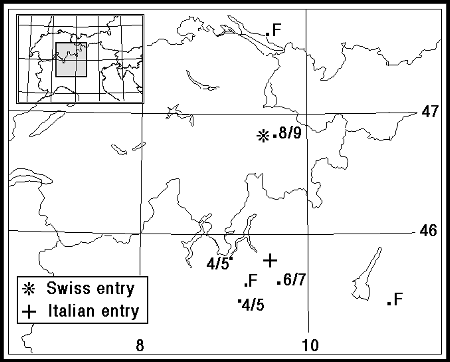
For these reasons the Italian catalogue compiled
a second record; this was also favoured by the fact that the Italian sources
mention Italian localities, while German sources mention localities North
of the Alps only.
The two records then survived the
"duplication inspections" performed by VGL.
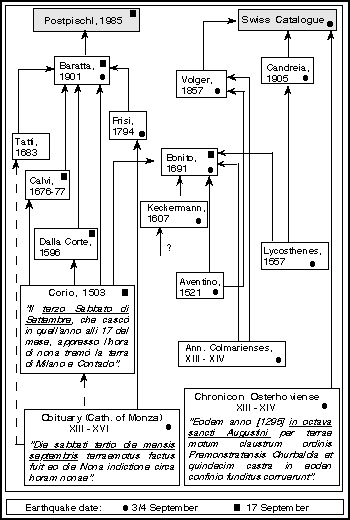
Fig.3 - Roots of the two entries representing the 1295, September earthquake in Central Alp.
1512-1513
| Cat | Date | Time | Lat | Lon | M | Io | Ep. Area |
| CH | 1512 | 46.38 | 08.97 | 7.0 | BIASCA | ||
| CH | 1512 02 08 | 46.30 | 09.38 | 6.0 | CHIAVENNA | ||
| ITA | 1513 02 10 | 46.17 | 09.00 | 5.7 | 9.0 | BELLINZONA |
The duplication of the first entry with the
third one was analysed by Albini et al. (1988). The most striking fact is
not that both entries refer to the same event, but that the event itself
is a fake quake; actually, what happened in the location proposed by the
Swiss catalogue was a landslide. The situation is complicated by the second
entry, the reliability of which is questionable.
1542
| Cat | Date | Time | Lat | Lon | M | Io | Ep. Area |
| CH | 1542 11 08 | 47.82 | 10.05 | 6.0 | WIGGENSBACH | ||
| D | 1542 11 08 | 47.83 | 10.00 | 6.0 | BAYERN |
Very probable duplication.
1616 and 1623
| Cat | Date | Time | Lat | Lon | M | Io | Ep. Area |
| CH | 1616 02 19 | 04 30 00 | 46.47 | 08.52 | 5.0 | VAL BEDRETTO | |
| CH | 1616 02 29 | 46.83 | 08.40 | 8.0 | ENGELBERG | ||
| CH | 1623 02 20 | 46.30 | 09.78 | 6.0 | CHIESA | ||
| ITA | 1623 03 01 | 01 00 00 | 46.22 | 10.15 | 5.0 | BIANZONE |
The first of these possible duplications originated
inside the Swiss catalogue, the other one originated when merging the Swiss
and the Italian catalogues. They are probably due to different calendars
(Julian and Gregorian) used by the sources.
1644
| Cat | Date | Time | Lat | Lon | M | Io | Ep. Area |
| ITA | 1644 02 15 | 44.00 | 06.75 | 5.7 | 9.0 | VAL VESUBIE | |
| FRA | 1644 02 15 | 04 30 00 | 43.88 | 07.30 | 8.5 | ALPES-MARIT. |
Duplication originated from different epicentral
locations, performed from the same dataset, but following different
parameterisation procedures.
1670
| Cat | Date | Time | Lat | Lon | M | Io | Ep. Area |
| ITA | 1670 07 16 | 15 | 45.43 | 10.97 | 4.4 | 6.5 | VERONA |
| A | 1670 07 17 | 02 00 00 | 47.30 | 11.50 | 5.3 | 8.0 | TIROL |
Well known example, discussed for instance by
Guidoboni and Stucchi (1993). The reason for this duplication is the use
of different time-systems by the sources, and uncorrect interpretation by
the compilers.
1690
| Cat | Date | Time | Lat | Lon | M | Io | Ep. Area |
| D | 1690 11 24 | 48.90 | 10.50 | 6.0 | BAYERN | ||
| A | 1690 12 04 | 15 45 00 | 46.60 | 13.80 | 6.2 | 9.0 | KAERNTEN |
| ITA | 1690 12 04 | 18 | 46.60 | 13.85 | 5.7 | 9.0 |
While the first entry is a possible
duplication, still under investigation (Eisinger and Gutdeutsch, 1994), the
Austrian and Italian entries are just unsorted duplications.
1743
| Cat | Date | Time | Lat | Lon | M | Io | Ep. Area |
| ITA | 1743 02 20 | 22 | 45.55 | 11.55 | 3.9 | 5.5 | VICENZA |
| GR | 1743 02 20 | 39. 0 | 20.30 | 6.9 | 9.0 | CORFU |
Classical example of duplication due to the
use of a limited set of sources (a local compiler, Piovene (1888), from Vicenza,
Italy), without data cross-checking from surrounding areas.
The earthquake was actually felt in Vicenza:
the distance between the two epicentres is more than 500 km.
1778
| Cat | Date | Time | Lat | Lon | M | Io | Ep. Area |
| A | 1778 01 28 | 47.20 | 09.60 | 2.5 | 6.0 | VORARLBERG | |
| D | 1778 01 28 | 02 30 | 47.90 | 07.60 | 6.5 | BADEN-WUERT. | |
| CH | 1778 01 29 | 00 30 00 | 47.20 | 09.82 | 5.0 | GR WALSERT. |
Possible duplication.
Lost earthquakes
Exactly in the symmetrical way as for duplications,
earthquakes may get lost from parametric catalogues. This can happen when
a catalogue covering a large area is partly used because, for many reasons,
another catalogue, covering a smaller area, inside the previous one, is preferred
for the small area itself.
For instance, in the catalogue of the Balkan
region (Shebalin et al., 1974) an entry describes, without parameters, an
earthquake of 1556 which, according to Hoff (1840) and his sources, affected
"Baiern, Österreich, Windischmark, Ungarn, Croatien, Dalmatien und
Mähren" (Fig. 4), damaging 26 localities.
This entry today survives in a Croatian earthquake
file only: the epicentre is located in the present Austrian territory and
Io is 10! Right or not these parameters, it is a matter of fact that the
Austrian part of the VGL catalogue ignores it, while no trace of this earthquake
is found in the territories of the neighbouring countries, according to their
catalogues.
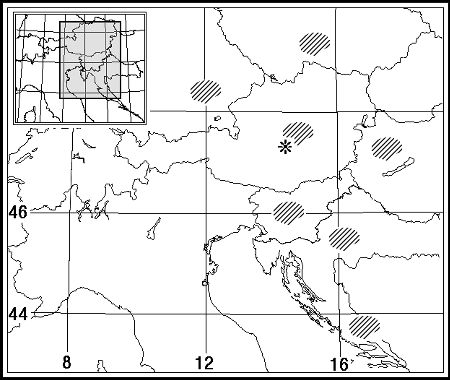
Wrong puzzle solutions
It can also happen that only some "pieces of
earthquake" get lost or, simply, that they float around looking for they
parent earthquakes and then they stick to the nearest one coming. This might
be due to the fact that earthquake parameters are often derived from different
sets of data - this is mostly the case with magnitudes - and put together
taking origin time as a guide.
But sometimes things go wrong. For instance,
a recent, oustanding magnitude re-evaluation of earthquakes of Italy and
sorrounding areas (Margottini and Screpanti, 1991), produced a final catalogue
attaching the new evaluated magnitudes to the Postpischl (1985) parameters
(To,
lo,
jo, etc). In this way, two large magnitude earthquakes,
with very small Io, appeared in nearly aseismic zones (Fig. 5). In this case
the VGL catalogue turns out useful, providing the solution:
| Cat | Date | Time | Lat | Lon | M | Io | Ep. Area |
| ITA | 1943 05 28 | 00 25 | 46 04 | 9 15 | 40 | MENAGGIO | |
| D | 1943 05 28 | 01 24 08 | 48 16 | 8 58 | 80 | BADEN-WUERTTEMB. | |
| ITA | 1955 11 23 | 06 24 40 | 45 54 | 11 00 | 40 | ROVERETO | |
| FRA | 1955 11 23 | 06 39 12 | 47 24 | 5 58 | 60 | HAUTE-SAONE |

The two magnitudes are to be attached to two
well assessed earthquakes in Germany and France respectively, of which the
Italian entries are just duplications. Unfortunately, neither Postpischl,
nor VGL, nor even Margottini and Screpanti sorted these duplications out.
Inhomogeneity and forced parameterisation
If the assumptions formulated in the introduction
are not met by data, the comprehensive catalogue may result formally homogeneous,
but its content may still be deeply inhomogeneous.
For instance, the VGL catalogue amalgamated
national catalogue which might be internally homogeneous, but which are surely
not homogeneous one to the other with special reference to: time-window,
historical sources, intensity scales, parameterisation procedures, magnitudes,
completeness.
More in detail, the VGL catalogue amalgamated
epicentral intensities expressed in different macroseismic scales and assessed
by varied "hands", including also figures like 6.3, and so on.
In the same way, magnitudes of different nature,
both instrumental and macroseismic, were taken from the input catalogues
and put all together in the same column, without qualification or warning
for the users. For instance, Fig. 6 clearly indicates the presence of
macroseismic magnitudes mixed together with instrumental ones in the Italian
data.
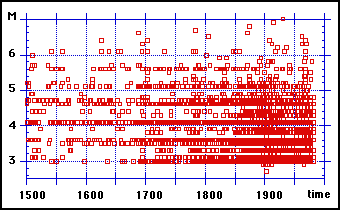
On the contrary, Fig. 7 shows that, in the data for Spain, magnitudes cover a limited time-window and they are nearly only instrumental.
One result of this situation is that, when a
user, unaware of such problems, plots magnitudes against epicentral intensities,
he gets the picture shown in Fig. 8. With the current regression procedures
a M = M(Io) correlation can certainly be obtained: but, what value will it
have?

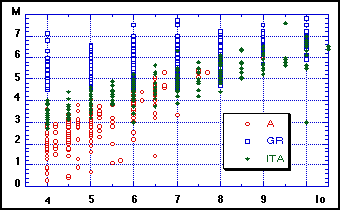
The depth column shows even more puzzling problems.
Fig. 9 shows that, for the Italian data, many depths are "fixed", according
to current procedures. Even more striking is that, for the Greek entries,
depth is constant at 70 km for most entries before 1960 (Fig. 10). Asked
about the reason, the Greek colleagues said that the material handled to
Van Gils contained only the information that "most Greek events are
intermediate".

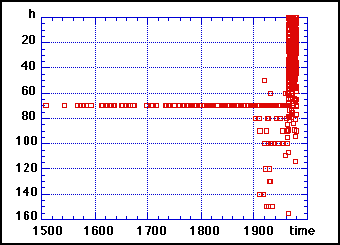
Apparently, this information was turned into
"70 km" for all events which did not carry a depth, probably because the
information did not fit in the space available in the depth column.
Now the problem is that, if an user wants to
investigate earthquake depths in Greece, he might be encouraged to assume
the VGL data as an evidence of a very large, active layer, at a depth of
about 70 km, covering all Greece and sorrounding areas.
Conclusions
The problems discussed show that handling those
useful tools called parametric catalogues with little care, might result
in a further step of earthquake data spoiling, after the main step represented
by the parameterisation of historical records.
Problems of duplication appear in some way
relatively easier to detect, with respect to homogeneity problems. For mastering
all these problems properly, it is necessary to retrieve and process the
primary data: playing with parameters usually increases the confusion.
Finally, it is to be stressed that a further problem is represented by the use which can be made of catalogues. Though this problem is not compiler's responsibility, however, compilers should be aware of it; it must be admitted that compilers sometimes do not help in this direction.
Acknowledgements
Working hard on this topic, authors are well
aware of how time-consuming and unrewarding the catalogue compilation may
be; they want to express respect and appreciation for the work of the colleagues.
References
Albini, P., Morelli, G. and Stucchi, M.,
1994. Alcuni terremoti importanti per l'Alta Valtellina. In: Studi sismici
in Alta Valtellina, ISMES-IRRS (CNR), pp. 24-50.
Albini, P., Bellani, A. and Stucchi, M.,
1988. Terremoti e frane nelle Alpi Centrali. Atti del 7° Convegno Annuale
del Gruppo Nazionale di Geofisica della Terra Solida, Roma, I, pp.
129-146.
Alexandre, P., 1991. The Seismic Cataclism
of 29 March 1000: Genesis of a Mistake. Tectonophysics, 193:
45-52.
Baratta, M., 1901. I Terremoti d'Italia.
Saggio di Storia, Geografia e Bibliografia Sismica Italiana con 136
sismocartogrammi. Torino, 950 pp.
Bellettati, D., Camassi, R. and Molin, D.,
1993. Fake quakes in Italy through parametric catalogues and seismological
compilations: case histories and typologies. Terra Nova, 5:
488-495.
Bernardis, G., Giorgetti, F., Nieto, D. and
Slejko, D., 1977. Earthquakes Catalogue for Eastern Alps Region. OGS Trieste
[computer printout].
Bonito, M., 1691. Terra tremante overo
continuatione de' terremoti dalla Creazione del Mondo fino al tempo presente
Ö Napoli, 822 pp.
Caloi, P., 1939. Il terremoto dell'Appennino
tosco-romagnolo dell'11 Febbraio 1939, La Ricerca Scientifica, X,
11.
Cancani, A., 1900. Notizie sui terremoti
osservati in Italia durante líanno 1899. Bollettino della Società
Sismologica Italiana, V.
Carrozzo, M.T., Cosentino, M., Ferlito, A.,
Giorgetti, F., Patané, G. and Riuscetti M., 1975. Earthquakes Catalogue
of Calabria and Sicily (1783-1973). Quad. Ric. Scient., 93, 216
pp..
Carrozzo, M.T., De Visentini, G., Giorgetti,
F. and Iaccarino, E., 1973. Catalogue of Italian Earthquakes. CNEN, RT/PROT
(73) 12, Roma.
Dell'Olio, A. and Molin, D., 1980. Catalogo
macrosismico del Lazio dall'anno 1000 al 1975. ENEA, Roma [internal
report].
Eisinger, U. and Gutdeutsch, R., 1994. The
Villach earthquake of December 4th, 1690 in the German sources. This
volume.
ENEL, 1978. Catalogo dei terremoti italiani
dallíanno 1000 al 1975. Roma [computer printout].
Guidoboni, E. and Stucchi, M., 1993. The
contribution of historical records of earthquakes to the evaluation of seismic
hazard. Annali di Geofisica, XXXVI, 3-4: 201-213.
Hoff, K.E.A. von, 1840. Chronik der Erdbeben
und Vulcan-Ausbrüche, IV. Gotha.
Karnik, V., 1969. Seismicity of the European
area. I, Dordrecht, 220 pp.
Malaroda, R. and Raimondi, C., 1957. Linee
di dislocazione e sismicità in Italia. Bollettino di Geodesia e Scienze
Affini, 16, 3: 273-323.
Margottini, C. and Screpanti, A., 1991. La
magnitudo dei terremoti italiani dal 1900 al 1986. ENEA, Roma [internal
report].
Mojsisovics, E. V., 1900. Allgemeiner Bericht
und Chronik der im Jahre 1899 innerhalb des Beobachtungsgebietes erfolgten
Erdbeben. Mitteilungen Erdbeben Commission der kaiserlichen Akademie der
Wissenschaften in Wien, 18.
Piovene C., 1888. Cronaca dei terremoti a
Vicenza. Annali dell'Ufficio Centrale di Meteorologia e Geodinamica, s. II,
VIII: 46-57.
Postpischl, D. (Editor), 1985. Catalogo dei
terremoti italiani dall'anno 1000 al 1980. Quad. Ric. Scient., 114, 2B, Bologna,
239 pp.
Ribaric, V., 1982. Seismicity of Slovenia.
Catalogue of Earthquakes (792 A.D.-1981). Ljubljana, 649 pp.
Shebalin, N.V., Karnik, V. and Hadzievski
D. (Editors), 1974. Catalogue of earthquakes. UNDP/UNESCO Survey of the
seismicity of the Balkan Region. Skopje, 600 pp.
Stucchi, M., 1994. Recommendations for the
compilation of a European parametric earthquake catalogue, with special reference
to historical records. This volume.
Van Gils, J.M., 1988. Catalogue of European
earthquakes and an atlas of European seismic maps. CEC, Report EUR 11344
EN.
Van Gils, J.M. and Leydecker, G., 1991. Catalogue
of European Earthquakes with intensities higher than 4. CEC, Nuclear Science
and Technology, Report EUR 13406 EN.
[Top]
[Vol.1]
[Vol.2]
[Deliverables and queries]
[Presentation]
[Homepage]